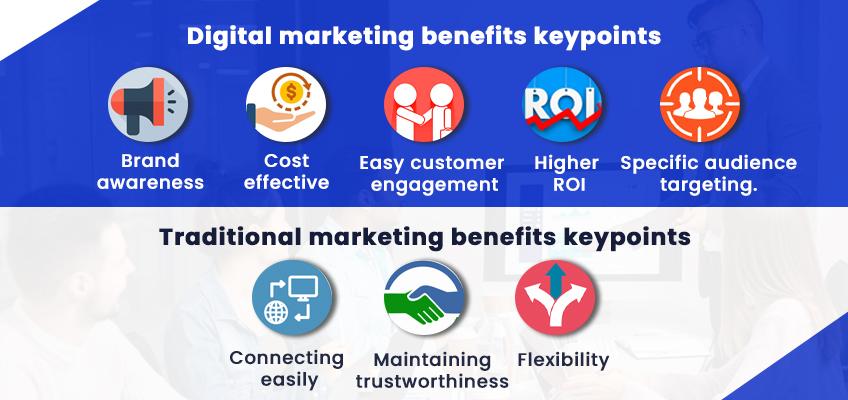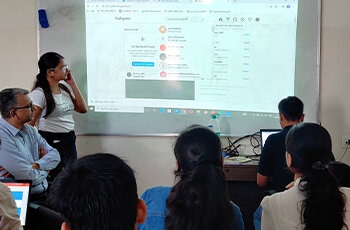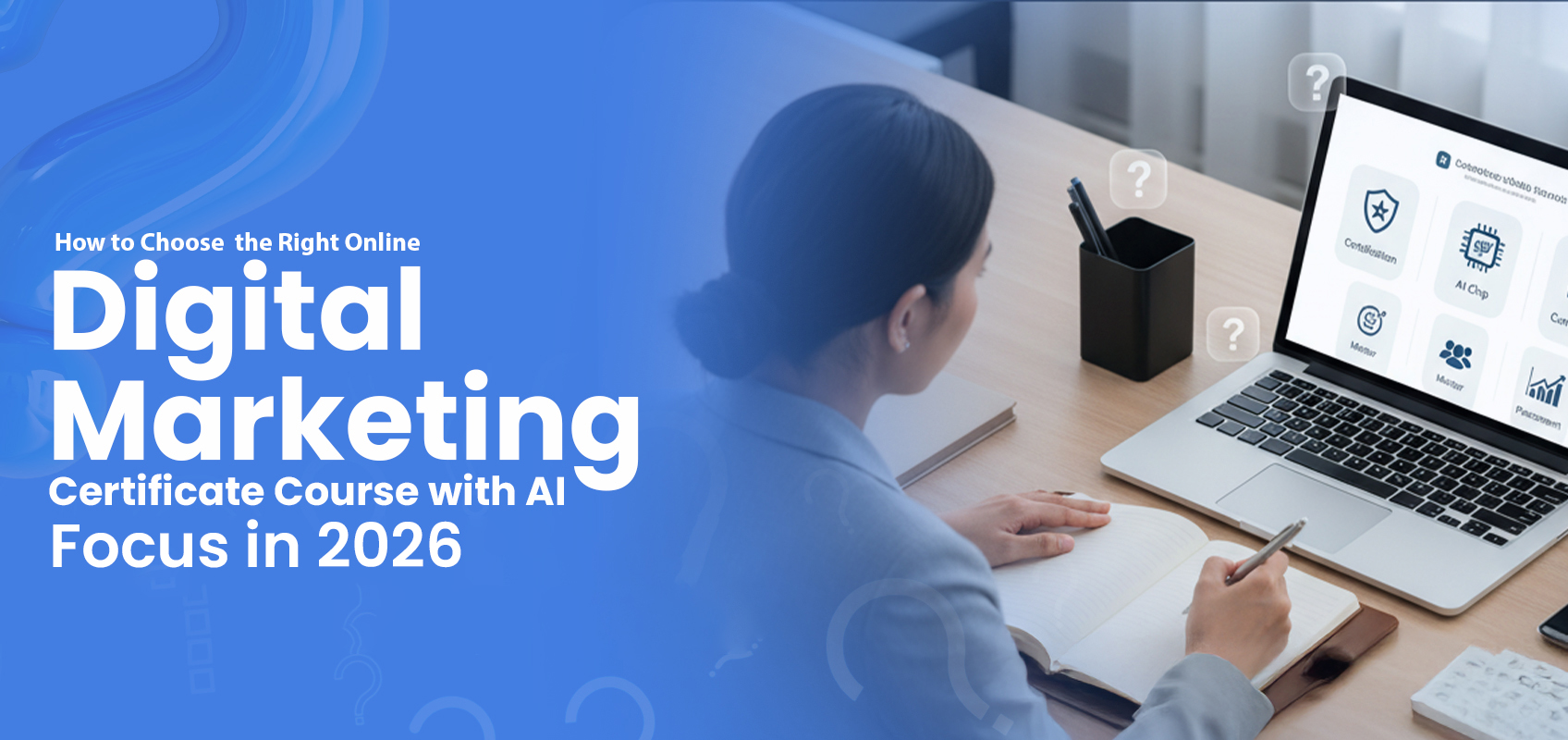Listen to this blog
Marketing is the most striking and rewarding field that isn’t just about selling products but about narrating stories. Traditional and digital are both effective types of marketing techniques that encompass businesses.
In the past, traditional marketing was the go-to career choice for many, but with the rise of careers in digital marketing, do you still see it as a promising field? Moreover, during the pandemic, digital marketing opportunities expanded significantly as people's preferences changed due to the impact of the COVID-19 crisis.
Table of Content
- What is Traditional Marketing?
- What is Digital Marketing?
- Modes of Traditional Marketing
- Modes of Digital Marketing
- Pros and Cons of Traditional Marketing
- Pros and Cons of Digital Marketing
- Digital Marketing vs Traditional Marketing: Choose the most prospective career path
- Frequently Asked Questions
- Conclusion
Let’s find it out in this article.
|
Point Of Comparison
|
Traditional Marketing
|
Digital Marketing
|
| Explanation |
An old type of marketing uses various offline mediums to promote products by creating brand awareness.
|
A modern type of marketing uses different digital channels to sell products or services to reach potential consumers.
|
|
Reach
|
Limited
|
Global
|
|
Targeting
|
Specific audience targeting is not possible
|
Specific audience targeting is possible
|
|
Retargeting
|
Re-engaging previous customers can’t be performed
|
Re-engaging previous customers can be effectively performed
|
|
Return on Investment
|
Hard to measure
|
Easily measurable
|
| Audience Tracking | Not possible | Possible |
| Conversion | Slow | Fast |
| Communication | One-way communication | Both-way communication |
Take the first step to becoming an expert digital marketer through the best digital marketing course today! Enroll Now!
What is Traditional Marketing?
Traditional marketing, or offline marketing, is when marketers follow the conventional way to interact with consumers by using television, newspapers, magazines, banners posters, etc. Traditional marketing is a conventional form of marketing that revolves around using mass media to promote businesses and connect with potential consumers. It is a comprehensive category that consists of many terms in advertising and marketing.
What is Digital Marketing?
Digital marketing is the most dynamic and modernized form of marketing in the evolution of technology, where marketers use various online platforms and digital channels such as social media, search engine optimization, email marketing, and many other channels to reach out to their potential audiences and encourage them to buy the product or services. Basic digital marketing skills entail identifying and capitalizing on a variety of chances in the ever-changing marketing landscape. Due to technological advancement, digital marketing has become an essential professional outfit for both students and job seekers.
You may also like to Read: How to Start a Career in Digital Marketing?
Key Importance of Traditional Marketing vs Digital Marketing
The following are some of the most important aspects of traditional and digital marketing:

Key Benefits of Traditional Marketing
- Easily connect with local audiences
- Building trustworthiness
- Acceptability and suitability
Key Benefits of Digital Marketing
- Building brand awareness and visibility
- Specific audience targeting
- Increasing customer engagement and getting real-time feedback
- Analyzing and optimizing data
- Fast conversion
- High return on investment
- Cost-effectiveness
Need specialized knowledge in digital marketing?
Make your mark on digital marketing with NIHT. Elevate your expertise in digital marketing with our affordable courses.
Modes of Traditional Marketing
- Printed Documents: Showcasing printed banners, hoarding, and advertisements in public areas to sell the product. Printed ads in newspapers, magazines, or journals.
- Billboards: Billboards are creative image advertisements that reach wide audiences from different locations to create brand recognition.
- Broadcasting: making commercial advertisements for television or radio
Modes of Digital Marketing
- Search Engine Optimization: It is an essential technique of digital marketing to increase the rank of web pages in Google search results and get traffic to the website with some amazing SEO strategies.
- Google Ads & Analytics: It is another important technique of digital marketing where marketers can promote their product by creating ads to capture the attention of their audiences. Google Analytics is an essential digital marketing tool where audience tracking can be performed to measure the business goal.
- Social Media Marketing: Marketers use social platforms, such as Facebook, Instagram, Twitter, Pinterest, and many other platforms, to promote their businesses and connect with potential audiences.
-
Content Marketing: Creating and delivering relevant and engaging content such as blogs, newsletters, social media posts, etc. for potential customers.
-
Email Marketing: Providing value to the customer by providing ending emails and encouraging them to engage with the business or services.
-
Affiliate Marketing: It is a mode of digital marketing where publishers can earn commissions by promoting products or services.
Pros and Cons of Traditional Marketing
The choice of marketing can vary depending on the goals or purposes of running a business. Traditional marketing has become a less effective marketing strategy for many marketers due to the expansion of digital marketing. Now look into the pros and cons of traditional marketing.
Pros:
- Reaching local audiences: Traditional Marketing can help attract the attention of a large, localized audience through various offline mediums, such as broadcast media, banner posters, etc.
- Building trustworthiness: This old method can be effective in understanding and solving customer queries and building trust by presenting ads on several offline mediums.
- Creating ad recall value: In this conventional system of marketing, ad recall value can be formed by showcasing the products or services multiple times on radio and television.
Cons:
- Time-taking process: It will take a month or year to get the best result, as audience tracking is not possible in traditional marketing. Since marketers cannot identify their potential customers, they cannot perform their marketing strategies and get satisfactory results from them. So the chances of conversion are also very low in this old practice of marketing.
- Money-consuming: It’s a huge investment to deliver printed posters to consumers or run ads on television, radio, magazines, or newspapers, as several factors are involved in this process.
Pros and Cons of Digital Marketing
Though online marketing is an excellent way to promote the business effectively among specific users, it also deals with some limitations. So let’s look into the pros and cons of digital marketing.
Pros:
- Instant audience tracking: Digital technologies aimed at developing various digital methods that are responsible for gathering data and instantly reaching a great number of potential audiences
- Less expensive and cost-effective solution: online marketing comes up with a less expensive and cost-effective solution for digital marketers. Profitability and marketability can be achieved through the tactics of detailed targeting.
- Global reach: digital marketing is poised to connect with a large portion of audiences by using social media or other digital channels. And the growth of digital mechanisms led to their widespread presence.
- Strong ROI: This modernized method ensures low investment and a high return policy, which is great relief and satisfaction for marketers.
- Growing Engagement Rate: increasing engagement rates is considered the most efficient aspect of digital marketing.
- Flexibility: Flexibility is another magical trait of digital marketing where marketers can easily control the budget or audience size to accomplish their purpose.
Cons:
- Continuous changes: New technologies are emerging and developing frequently, so digital marketing tactics need to be assessed continuously. So it’s a bit problematic for marketers to analyze the data and optimize the insights, as it requires expertise and knowledge in the digital field.
- Consistency in Quality: Maintaining consistent content quality can be a challenging factor in digital marketing. Consistently delivering valuable and engaging content based on audience preferences and business objectives can ensure credibility and achievement.
Digital Marketing vs Traditional Marketing: Choose the most prospective career path
There’s no point in denying the fact that a career in digital marketing is indeed a profound option for youngsters or job seekers who are looking for professional development in digital marketing. In today’s world, due to the explosion of AI and digital advancement, jobs in digital marketing outfits are in high demand, where you can get ample scope and opportunities to grow your professional expertise. If you are chasing after your dream of an MBA, but can’t afford that premium, expensive marketing program, you’ll be surprised to know that digital marketing comes with a 16-month Master Program that provides students with comprehensive knowledge of digital learning.
Conclusion
Nowadays, the marketing industry is rapidly growing and advancing in digital technologies, and marketers are expanding their digital horizons by making an impact on their audience’s minds. Both traditional marketing and digital marketing are responsible for accomplishing remarkable business goals. But as we enter the digital world and become dependent on social media, digital marketing has become preferred over offline marketing.
Also Read : Digital Marketing Course After 12th in 2025: Placement, Fees, and Modules
Frequently Asked Questions
|
Point Of Comparison
|
Traditional Marketing
|
Digital Marketing
|
|
Reach
|
Local |
Global
|
| Engagement rate | Slow | high |
| Conversion | slow | fast |
| Targeting |
Specific audience targeting is not possible
|
Specific audience targeting is possible |
|
Audience Tracking
|
Not Possible | Possible |
- Search Engine Optimization (SEO)
- Social Media Marketing
- Email Marketing
- Affiliate Marketing
- Content Marketing
- Mobile Marketing
- Pay-Per-Click
- Google Ads & Analytics
- Specific targeting: The digital transition in marketing marked a new era by granting detailed targeting based on the demographics, hobbies, or interests of the probable audiences.
- Fast and quick conversion: Today’s digital hub inspires its audiences to look into the various brands and inspires them to convert quickly and instantly by creating an impact on their minds. So the growth of conversion is a beneficial effect of digital techniques.
- Cost-effectiveness: Low-cost rule has always been a priority metric for marketers. Digital marketers aim to create successful campaigns to meet their marketing objectives on a very affordable budget.
- High engagement rate: It is a highly modernized field that allows building connections with a large set of audiences, which enhances the brand’s visibility and recognition.
.jpg)
(1).jpg)









